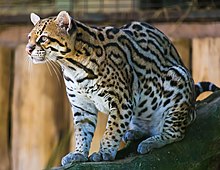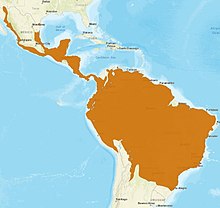
Back Leopardus pardalis AN أصلوت Arabic اصلوت ARZ Оцелот AV Lotkol (Leopardus pardalis) AVK Oselot Azerbaijani اوْسلوت AZB Ocelot BAN Ацэлот Byelorussian Ацэлёт BE-X-OLD
| Ocelot | |
|---|---|

| |
| An ocelot in a zoo in Brazil | |
| Scientific classification | |
| Domain: | Eukaryota |
| Kingdom: | Animalia |
| Phylum: | Chordata |
| Class: | Mammalia |
| Order: | Carnivora |
| Suborder: | Feliformia |
| Family: | Felidae |
| Subfamily: | Felinae |
| Genus: | Leopardus |
| Species: | L. pardalis
|
| Binomial name | |
| Leopardus pardalis | |
| Subspecies | |
| |

| |
| Distribution of the ocelot (2016)[1] | |
| Synonyms[2] | |
|
List
| |
The ocelot (Leopardus pardalis) is a medium-sized spotted wild cat that reaches 40–50 cm (15.7–19.7 in) at the shoulders and weighs between 7 and 15.5 kg (15.4 and 34.2 lb) on average. It is native to the southwestern United States, Mexico, Central and South America, and the Caribbean islands of Trinidad and Margarita. Carl Linnaeus scientifically described it in 1758. Two subspecies are recognized.
The ocelot is efficient at climbing, leaping and swimming. It prefers areas close to water sources with dense vegetation cover and high prey availability. It preys on small terrestrial mammals, such as armadillos, opossums, and lagomorphs. It is typically active during twilight and at night and tends to be solitary and territorial. Both sexes become sexually mature at around two years of age and can breed throughout the year; peak mating season varies geographically. After a gestation period of two to three months, the female gives birth to a litter of one to three kittens. They stay with their mother for up to two years, after which they leave to establish their own home ranges.
The ocelot is listed as Least Concern on the IUCN Red List and is threatened by habitat destruction, hunting, and traffic accidents. While its range is very large, various populations are decreasing in many parts of its range. The association of the ocelot with humans dates back to the Aztec and Incan civilizations; it has occasionally been kept as a pet.
- ^ a b c Paviolo, A.; Crawshaw, P.; Caso, A.; de Oliveira, T.; Lopez-Gonzalez, C.A.; Kelly, M.; De Angelo, C. & Payan, E. (2016) [errata version of 2015 assessment]. "Leopardus pardalis". IUCN Red List of Threatened Species. 2015: e.T11509A97212355. doi:10.2305/IUCN.UK.2015-4.RLTS.T11509A50653476.en. Retrieved 17 January 2022.
- ^ Cite error: The named reference
mammalwas invoked but never defined (see the help page).
© MMXXIII Rich X Search. We shall prevail. All rights reserved. Rich X Search
